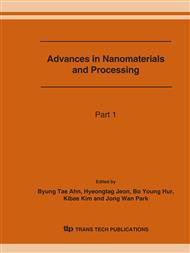[1]
W. Choi, A. Termin and M.R. Hoffmann: J. Phys. Chem. Vol. 98 (1994), p.13669.
Google Scholar
[2]
R. Asahi, T. Morikawa, T. Ohwaki, A. Aoki and Y. Taga: Science Vol. 293, (2001), p.269.
Google Scholar
[3]
B. O'Regan and M. Grätzel: Nature Vol. 353, (1991), p.737.
Google Scholar
[4]
M. Anpo and M. Takeuchi: J. Catal. Vol. 216, (2003), p.505.
Google Scholar
[5]
H.E. Chao, Y.U. Yun, H.U. Xingfang and A. Larbot: J. European Ceram. Soc. Vol. 23, (2003), p.1457.
Google Scholar
[6]
D. Madare, M. Tasca, M. Delibas and G.I. Rusu: Appl. Surf. Sci. Vol. 156, (2000), p.200.
Google Scholar
[7]
M.M. Rahman, K.M. Krishna, T. Soga, T. Jimbo and M. Umeno: J. Phys. Chem. Solids Vol. 60, (1999), p.201.
Google Scholar
[8]
K.M. Krishna, M. Mosaddeq-ur-Rahman, T. Miki, K.M. Krishna, T. Soga, K. Igarashi, S. Tanemura and M. Umeno: Appl. Surf. Sci. Vol. 113-114, (1997), p.149.
DOI: 10.1016/s0169-4332(96)00873-2
Google Scholar
[9]
D.H. Kim, H.S. Hong, S.J. Kim, J.S. Jong and K.S. Lee: J. Alloys and Compounds Vol. 375, (2004), p.259.
Google Scholar
[10]
Q.G. Yan, W.Z. Weng, H.L. Wan, H. Toghiani, R.K. Toghani and C.U. Pittman Jr.: Appl. Catal. A Vol. 239, (2003), p.43.
Google Scholar
[11]
T. Umebayashi, T. Yamaki, H. Itoh and K. Asai: Appl. Phys. Lett. Vol. 81, (2002) 454.
Google Scholar
[12]
W. Kohn and L.J. Sham: Phys. Rev. Vol. 140, (1965), p. A1133.
Google Scholar
[13]
J.P. Perdew, J.A. Chevary, S.H. Vosko, K.A. Jackson, M.R. Pederson, D. J. Singh and C. Fiolhais: Phys. Rev. B Vol. 46, (1992), p.6671.
DOI: 10.1103/physrevb.46.6671
Google Scholar
[14]
G. Kresse and J. Hafner: Phys. Rev. B Vol. 47, (1993), p. RC558.
Google Scholar
[15]
H.J. Monkhorst and J.D. Pack: Phys Rev. B Vol. 13, (1976), p.5188.
Google Scholar
[16]
P.E. Blöchl, O. Jepsen and O.K. Andersen: Phys. Rev B Vol. 49, (1994), p.16223.
Google Scholar
[17]
J. Muscat, V. Swamy and N.M. Harrison: Phys Rev. B Vol. 65, (2002), p.224112.
Google Scholar
[18]
B. Montanari and N.M. Harrison: Chem. Phys. Lett. Vol. 364, (2002), p.528.
Google Scholar
[19]
J. Goniakowski, J.M. Holender, L.N. Kantorovich and M.J. Gillan: Phys. Rev. B Vol. 53, (1996), p.957.
Google Scholar
[20]
C. Lee, P. Ghosez and X. Gonze: Phys. Rev. B Vol. 50, (1994), p.13379.
Google Scholar
[21]
M. Mattesini, J.S. de Almeida, L. Dubrovinsky, N. Dubrovinskaia, B. Johansson and R. Ahuja: Phys. Rev. B Vol. 70, (2004), p.115101.
Google Scholar
[22]
R.M. Martin: Electronic Structure (Cambridge University Press, United Kingdom 2004), p.264.
Google Scholar
[23]
K.M. Glassford and J. R, Chelikowsky: Phys. Rev. B Vol. 46, (1992), p.1284.
Google Scholar
[24]
D.H. Kim, K.S. Lee, Y. -S. Kim, Y. -C. Chung and S. -J. Kim: J. Am. Ceram. Soc. Vol. 89, (2006), p.515.
Google Scholar


